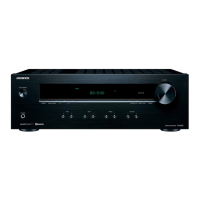
Do you have a question about the Onkyo TX-8220 and is the answer not in the manual?
| Receiver type | stereo |
|---|---|
| Frequency range | 10 - 100000 Hz |
| Audio output channels | 2.1 channels |
| Total Harmonic Distortion (THD) | 0.08 % |
| Dynamic power per channel (3 Ohm) | 140 W |
| Dynamic power per channel (4 Ohm) | 120 W |
| Dynamic power per channel (8 Ohm) | 80 W |
| Power output per channel (20-20KHz@8 Ohm) | 100 W |
| Package depth | 401 mm |
| Package width | 533 mm |
| Package height | 234 mm |
| AC input voltage | 220 - 240 V |
| AC input frequency | 50 - 60 Hz |
| Power consumption (standby) | 0.4 W |
| Power consumption (typical) | 20 W |
| FM band range | 87.5 - 108 MHz |
| Supported radio bands | DAB+, FM |
| HDMI in | 0 |
| Digital audio coaxial in | - |
| Digital audio optical in | 1 |
| Connectivity technology | Wired |
| Speakers connectivity type | Binding post |
| Bluetooth | Yes |
| Ethernet LAN | No |
| Product color | Black |
| Depth | 328 mm |
|---|---|
| Width | 435 mm |
| Height | 149 mm |
| Weight | 7000 g |
The primary TX-8220 stereo receiver unit.
Includes the remote control and necessary batteries for operation.
Details FM/DAB and AM indoor antennas provided with the unit.
The main document guiding users on the product.
ON/STANDBY and DIRECT/TONE buttons for power and sound modes.
MEMORY, TUNING/PRESET, INPUT buttons for radio and source selection.
VOLUME knob for audio level and PHONES jack for headphones.
The display screen and Bluetooth indicator status lights.
SPEAKER A/B, BASS, TREBLE, BALANCE controls.
Lights for speaker system, headphones, and PCM signal input.
Indicators for preset modes, tuning status, muting, and digital input types.
Displays radio info, sleep timer, and auto standby status.
GND, FM/AM, and DAB/FM antenna connection points.
SUBWOOFER PRE OUT, LINE OUT, and SPEAKERS A/B terminals.
Power cord socket, AUDIO IN, and DIGITAL IN jacks.
ON/STANDBY, SLEEP, and INPUT SELECTOR buttons for basic control.
D.TUN, TUNING, PRESET, and VOLUME buttons for radio and audio level.
Cursor, ENTER, SETUP, and RETURN buttons for menu operation.
BASS, TREBLE, TONE, DIRECT buttons for audio customization.
PAIRING, CLEAR, and DISPLAY buttons for wireless and screen settings.
Requirements for speaker impedance and proper cable connection.
Setup for Speaker A, B, or A+B output and impedance settings.
How to connect a powered subwoofer using the PRE OUT jack.
Connecting devices via optical or coaxial digital cables.
Notes that only PCM audio is supported for digital inputs.
Using analog audio cables for devices like CD players or turntables.
Specifics for MM/MC cartridges and turntable ground wire.
Positioning FM and AM antennas for best signal.
Guidelines for connecting the power cord safely.
Positioning DAB/FM antennas for best signal.
Guidelines for connecting the power cord safely.
How to play audio from external devices connected to the unit.
Using the remote to switch to the correct input for playback.
Connecting and playing music from Bluetooth-enabled devices.
Steps to pair a smartphone or other device with the receiver.
Playing music and adjusting volume after a successful connection.
Unit scans for stations automatically when TUNER is activated.
How to tune stations manually and set mono reception.
Direct entry of station frequencies using number buttons.
Shows scrolling text data broadcast by FM stations.
Locating stations based on genre like News, Rock, or Jazz.
Basic steps to scan and select DAB stations.
Details like DLS, Program Type, Bit Rate, and Signal Quality.
Sorting stations alphabetically or by multiplex.
Saving desired radio stations using the MEMORY function.
Recalling pre-stored radio stations via PRESET buttons.
Removing unwanted stations from the preset memory.
Assigning up to 8 characters to identify preset stations.
Instructions on using buttons for typing and confirming names.
Adjusting bass and treble frequencies for desired sound.
Switching between pure sound (DIRECT) and tone adjustment (TONE).
Fine-tuning sound output balance between left and right speakers.
How to enter and move through the unit's advanced settings menu.
Configuring auto standby and assigning digital input sources.
Managing station presets, editing names, and setting tuning modes.
Adjusting FM search sensitivity and station display order.
Performing scans for new or updated DAB radio stations.
Adjusting dynamic range for clearer quiet parts in DAB broadcasts.
Enabling/disabling Bluetooth, managing connections, and auto-reconnect.
Viewing connected device status and clearing pairing data.
Setting the timer for automatic unit standby.
Basic steps like power cycling and factory reset for problem solving.
Resolving issues with unit power and sound output.
Diagnosing issues with connected devices and speaker audio.
Addressing audio noise, interference, and poor AM/FM reception.
Solving problems with Bluetooth pairing, connection, and audio playback.
Troubleshooting issues with the remote and the unit's display.
Addressing strange noises or other unexpected unit behaviors.
Technical details for audio amplification and radio tuning functions.
Specifications for Bluetooth connectivity, power, dimensions, and inputs/outputs.